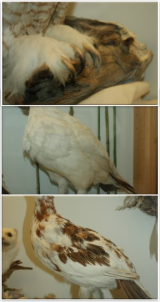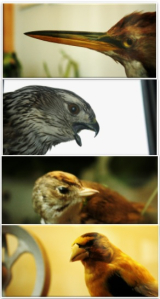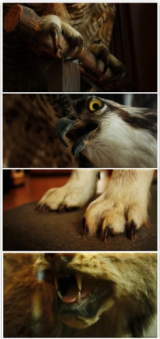Introduction to our Quebec Biodiversity exhibits
Fur
The fur of mammals protects them from the cold of Quebec winters. Their body is insulated from the cold dry air that surrounds them by the thick fur layer. Fur is also important because it allows some animals to camouflage themselves within the white snow, such as the polar bear. In the summer, some species such as the Arctic fox, shed their fur so that they can camouflage in the darker environment of the summer tundra.
Photos: Polar bear, Muskox, Arctic Fox and Grey Wolf FUR in the Redpath Museum Quebec Biodiversity exhibit area.
 Feathers
Feathers
The birds that live in the Arctic conditions of Quebec also adapted to living in the cold. For example, birds such as the Snowy owl and the Willow ptarmigan have evolved feathers to cover the legs and feet, which insulates them like the rest of their body to prevent heat loss. The ptarmigan also sheds its white winter feathers for a darker summer plumage to better hide from predators in the tundra.
Photos: Snowy owl, Willow ptarmigan (winter), Willow Ptarmigan (summer) FEATHERS in the Redpath Museum Quebec Biodiversity exhibit area.
 Beak diversity
Beak diversity
Birds have evolved to feed on many different types of food items. The diversity of feeding habits can be determined by the type of beaks they have. Piscivorous species will have long and slender beaks to harpoon fish. Carnivorous species will have raptorial beaks to tear flesh from their prey. Insectivorous species will have short and narrow beaks to catch insects. Granivorous species will have short and bulky beaks to break nuts and seeds.
Photos: American Bittern, Northern Goshawk, Ovenbird, Evening Grosbeak showing BEAK DIVERSITY.
 Predation
Predation
Predators have evolved several features to increase their chance of catching prey. Birds of prey possess strong talons to not only catch their prey, but also to hold it down while tearing pieces off with its raptorial beak. Mammalian predators have evolved similar features, such as strong claws to catch their prey and large canine teeth to tear off pieces of muscle and soft tissue.
Photos: Great Horned Owl, Osprey, Grey wolf, Canada Lynx showing features of PREDATION in the Quebec Biodiversity exhibit area.
 Conservation
Conservation
The museum displays many specimens of threatened, endangered and even extinct species that lived in Quebec. These exhibits give us an appreciation of how some Quebec species have been affected by humans. Some of these are listed by the IUCN as 'species at risk' and some are species that are already listed as 'extinct' such as the Passenger Pigeon. The IUCN is the global authority on the status of the natural world and the measures needed to safeguard it.
Photos: Passenger pigeon, Atlantic cod, and Harlequin duck in the Quebec Biodiversity exhibit area at the Redpath Museum.
All Teacher's Resource booklets for teaching Quebec Biodiversity are available for free download here:
ELEMENTARY SCHOOL LEVELS
![]() teacher_resources_elementary_school_cycle_1.pdf
teacher_resources_elementary_school_cycle_1.pdf
SECONDARY SCHOOL LEVELS
